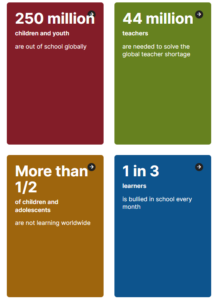Education
UNESCO’s Happy Schools Initiative: Placing Happiness at the Heart of Education
In a progressive move to reshape global education, UNESCO has developed the ‘Happy Schools’ initiative to place happiness at the forefront of educational transformation. By positioning happiness as both a means and an end to quality learning, this initiative encourages education systems worldwide to recognise happiness as a critical driver of learning and well-being.
Why Happiness Matters in Education
The Happy Schools initiative stems from an ever-growing body of evidence linking happiness with improved learning, teaching, and overall well-being. Academic excellence and happiness are not competing priorities; instead, they work hand in hand. Joyful learning environments enhance creativity, motivation, and the overall learning experience, thus improving educational outcomes.
Education systems face mounting pressure to provide quality learning in the face of widespread global challenges. Currently, 250 million children and youth are out of school worldwide, and over 44 million teachers are required to meet the global teacher shortage. Alarmingly, more than half of the world’s children and adolescents aren’t learning effectively, and one in three students experiences bullying at school every month. Given this backdrop, prioritising happiness is no longer a luxury but a necessity for fostering resilient and collaborative societies.
The Framework of the Happy Schools Initiative
UNESCO has developed a comprehensive Happy Schools framework that consists of four pillars: people, process, place, and principles. These pillars, combined with 12 high-level criteria, aim to provide a flexible and adaptable guide for transforming education systems.
1. People: Promoting relationships, inclusion, and respect among students and staff to foster social cohesion and well-being.
2. Process: Encouraging dynamic and participatory learning processes that inspire engagement, creativity, and motivation.
3. Place: Creating safe, welcoming, and inclusive learning environments that support both physical and social-emotional well-being.
4. Principles: Upholding values of empathy, integrity, and respect while ensuring academic excellence.
Global Impact and Implementation
Several countries have already implemented the Happy Schools initiative, including Portugal, Viet Nam, Yemen, Japan, Lao People’s Democratic Republic, and Thailand. These nations have utilised the framework to improve teacher training, strengthen socio-emotional learning, and foster healthier school relationships. By approaching happiness from various entry points, the initiative has proven to be versatile and adaptable to different education systems, even in crisis situations.
Joining the Happy Schools Movement
UNESCO invites educators, policymakers, and individuals to become Happy Schools champions, advocating for happiness in education through these main approaches:
– National Projects: UNESCO provides technical support to help Member States adapt the framework to their educational systems.
– Self-initiated Projects: Schools and organisations can access the available public resources to lead their own Happy Schools projects.
– Advocacy: Advocate for incorporating happiness into education policies to raise awareness of the importance of well-being in education.
– Evidence-Based Studies: Contribute to the growing body of research on happiness and learning.
For those interested in joining the Happy Schools mission, contact UNESCO at happyschools@unesco.org or join the LinkedIn community for regular updates and connections. By embracing this holistic approach, we can empower children to flourish, thrive, and build resilient, happy societies.
